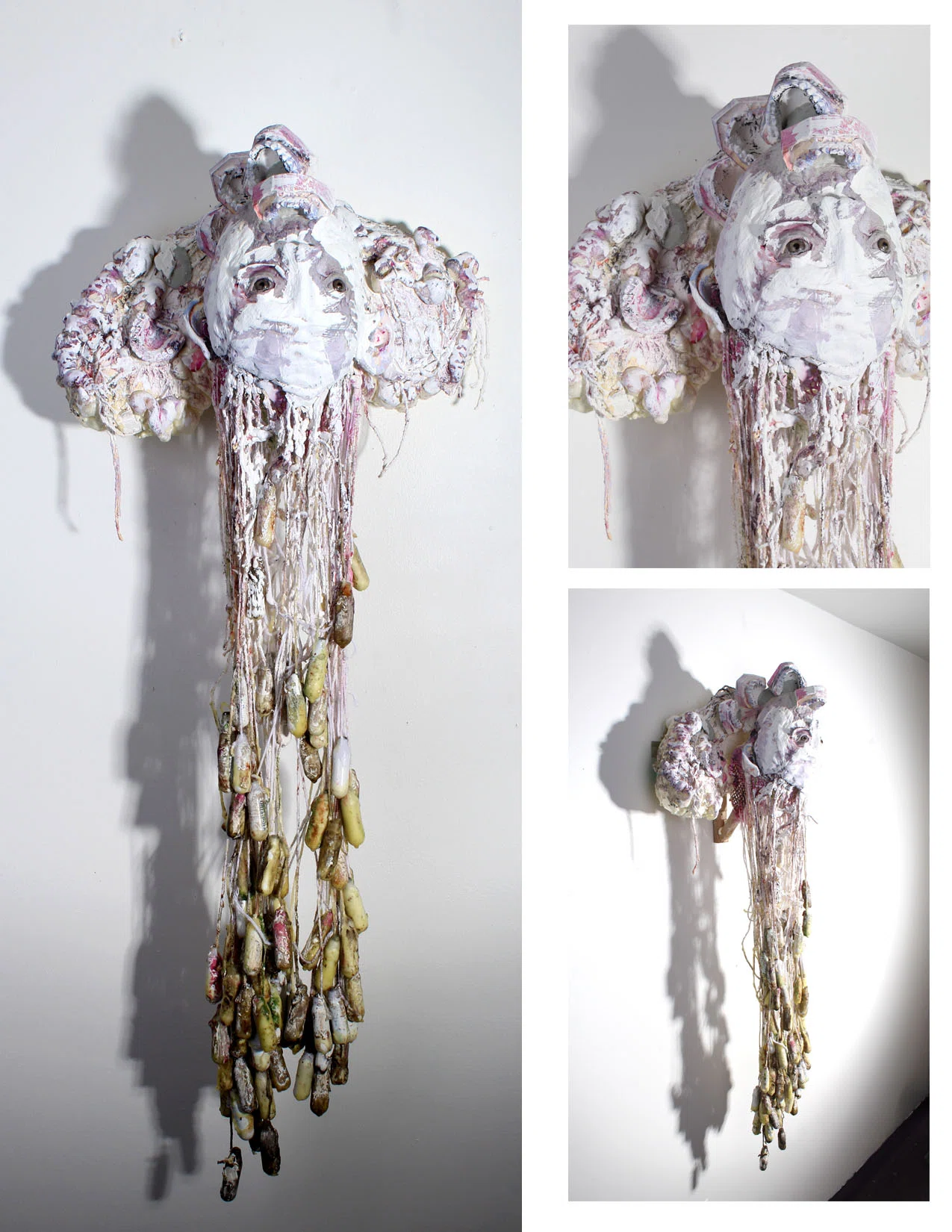

AP 3-D
Noah Hevel
Acalanes Center for Independent Study|Walnut Creek, California


Dimensions: 48” x 16” x 15”|Material(s): Veraform, spray foam, epoxy clay, found CO2 cans, yarn, found dental casts, eye, acrylic + wax|Process(es): Shape face, make an armature, assemble hanging pieces, build facial feature, wax + paint final form|Curatorial Note: Wonderful example of an abstracted figurative work where we can relate to it’s physical creepiness that seems closer to a nightmare than to a dream—exciting use of materials.
Student statement (TRANSCRIPT)
Student statement (TRANSCRIPT)
Listen to the student statement
My name is Noah Hevel. I am a half-Korean, White Bay Area rock climber with a love for bonsai, but mainly, I am a sculptor. I have always been a sculptor, and I have always made work connected to my body. Since age five, I have made complex puppets with internal armatures from socks, ping pong balls, fur, and stolen pantyhose from my mom's dresser. As a little kid, I ran the neighborhoods, caped with milk jugs and cereal boxes on my head. My superpower has constantly been resourcing and claiming. For the past year and a half, I've been scavenging junk yards, dumpsters, and secondhand stores for objects that convey the body. I look everywhere for materials; a massive thread becomes guts, rusted metal becomes a spine, and cardboard planters become eye sockets by combining these found materials with spray foam, epoxy, putty, plaster, metal, and resin.
My work tells a story. It is a turbulent story of pain, sadness, and tension. It is grotesque and makes the viewer uncomfortable to be in its presence. The sculpture selected for the 2023 AP Art and Design exhibit is from my body of work called Sorrows into Strangers. Titled My Humbled Gaze, this piece represents one's helplessness in moving forward. Weighted strands of resourced materials, beeswax, thread, and paint hold down the stretched figure. It is frozen in its suffering, unable to get back up.
"My Humbled Gaze"
Teacher statement
Teacher statement
Rachel Hallquist
David Hevel
Throughout my career, there have been rare moments where a young artist's creation has stopped me in my tracks. These were not mere showcases of learned skills but genuine works of art. Time and again, Noah has astounded me with exceptionally thought-provoking work that didn't just depict his ideas but radiated them.
Noah has an innate instinct for delving into materials and a deep curiosity for the sensory aspects of sculpting, casting, and modeling. His remarkable ability to seamlessly integrate concept and form is awe-inspiring. Serving as one of Noah's AP mentors this year has been an immense pleasure. I am uniquely proud of his accomplishments, mainly because he is my son. Congratulations on this remarkable accomplishment! ~David Hevel
Noah took the initiative to construct his art portfolio independently throughout the year. Given that his current school lacks an AP art program, he proactively sought the guidance of Dr. Hallquist, a long-standing family friend and teacher, along with my support. We both played distinct roles in his artistic journey. My role involved introducing Noah to diverse casting materials and techniques encouraging him to explore these artistic avenues freely and expressively in his studio. Throughout the year, Dr. Hallquist supported Noah with documenting his practice, experimentation, and revisions through working in a sketchbook, photographing work in progress, and reflecting in writing.
We initiate the AP process by assisting the students in formulating an essential question they aim to address throughout the year. We engage in multiple sessions of writing, editing, and refining various intriguing questions before settling on a single one. Frequently, this initial question evolves or transforms as they progress in their inquiry, yet the students consistently contemplate their work as a response to this fundamental query.
Students engage in cycles of creative inquiry, beginning with investigating an aspect of their investigation, such as an art material, a creative process, or an idea. Next, they often plan how to use what they learned through their research. As they plan, they review and refine their work. Finally, they reflect on their work, gleaning insights and new questions. The cycle of inquiry then begins again.
Noah leveraged his sketchbook to develop ideas and as a dedicated research tool. Dr. Hallquist and I guided him in exploring contemporary artists using similar materials. He documented what intrigued him about their work and delved into these artists' construction methods. Most of the sketchbook became a place of writing, and his materials became a place of sketching and building. We used word association activities that expanded his vocabulary around emotions and reflective writing prompts, and we guided Noah to explore sculptures from antiquity that depicted the human body.
Exploration and innovation are fundamental to crafting successful artwork. Noah found joy in working with plaster for his first piece of the year. However, he aimed to move beyond literal representation. Transitioning towards more abstract forms in his work, Noah ventured into experimenting with using his materials to express emotions rather than focusing solely on accurately depicting the body. We both encouraged this exploration during one-on-one critique, focusing on reconnecting with the original essential question.
Noah is an exceptional and high-achieving AP Art and Design student who independently develops his ideas and solves problems uniquely. He showed immediate progress, thoughtfulness, and dedication by mapping out a rigorous and imaginative course of inquiry at the beginning of the program.
Noah's passion for art shines through every piece he creates, from rough sketches to polished masterpieces. His dedication to experimentation and his fearless attitude towards new materials and techniques inspire us all. Keep up the fantastic work, Noah!
Noah Hevel



